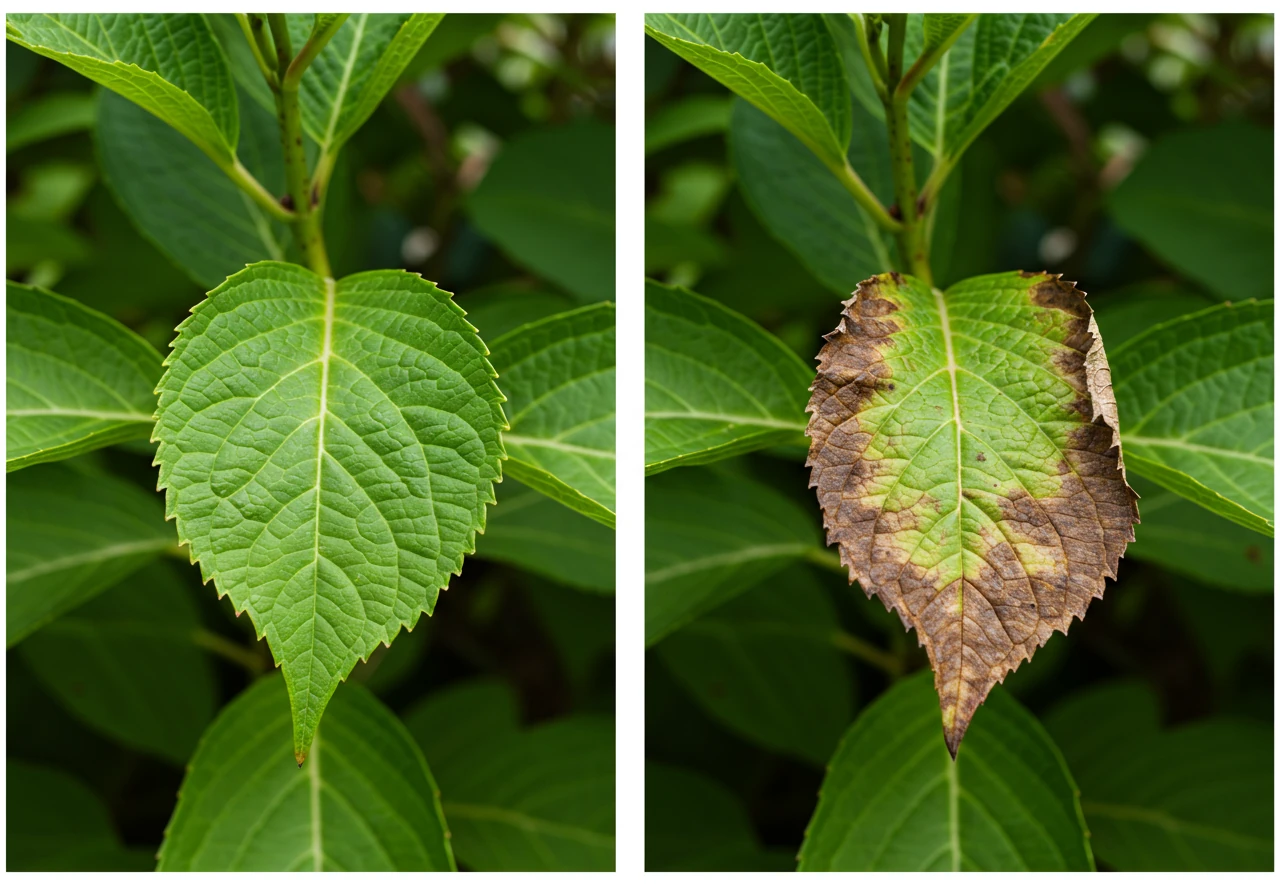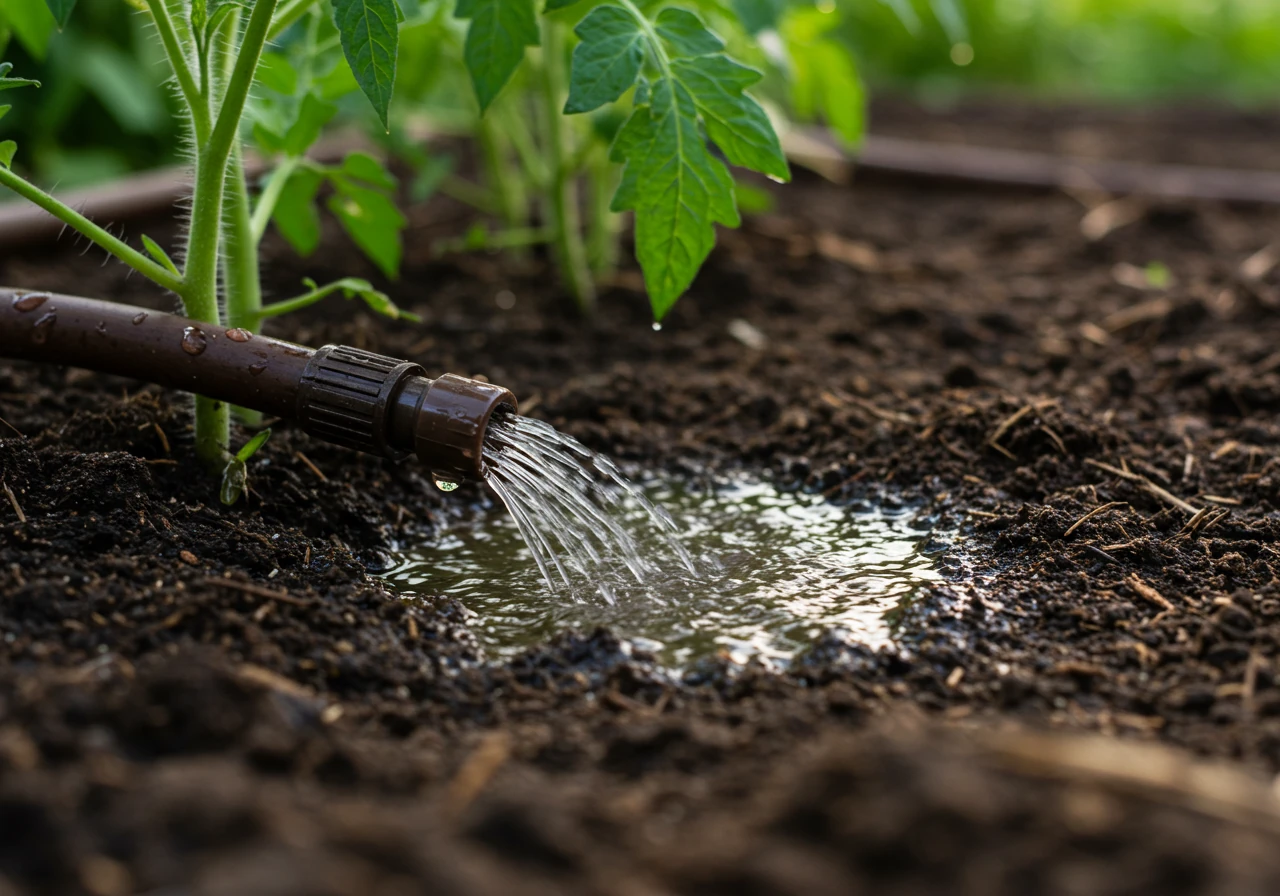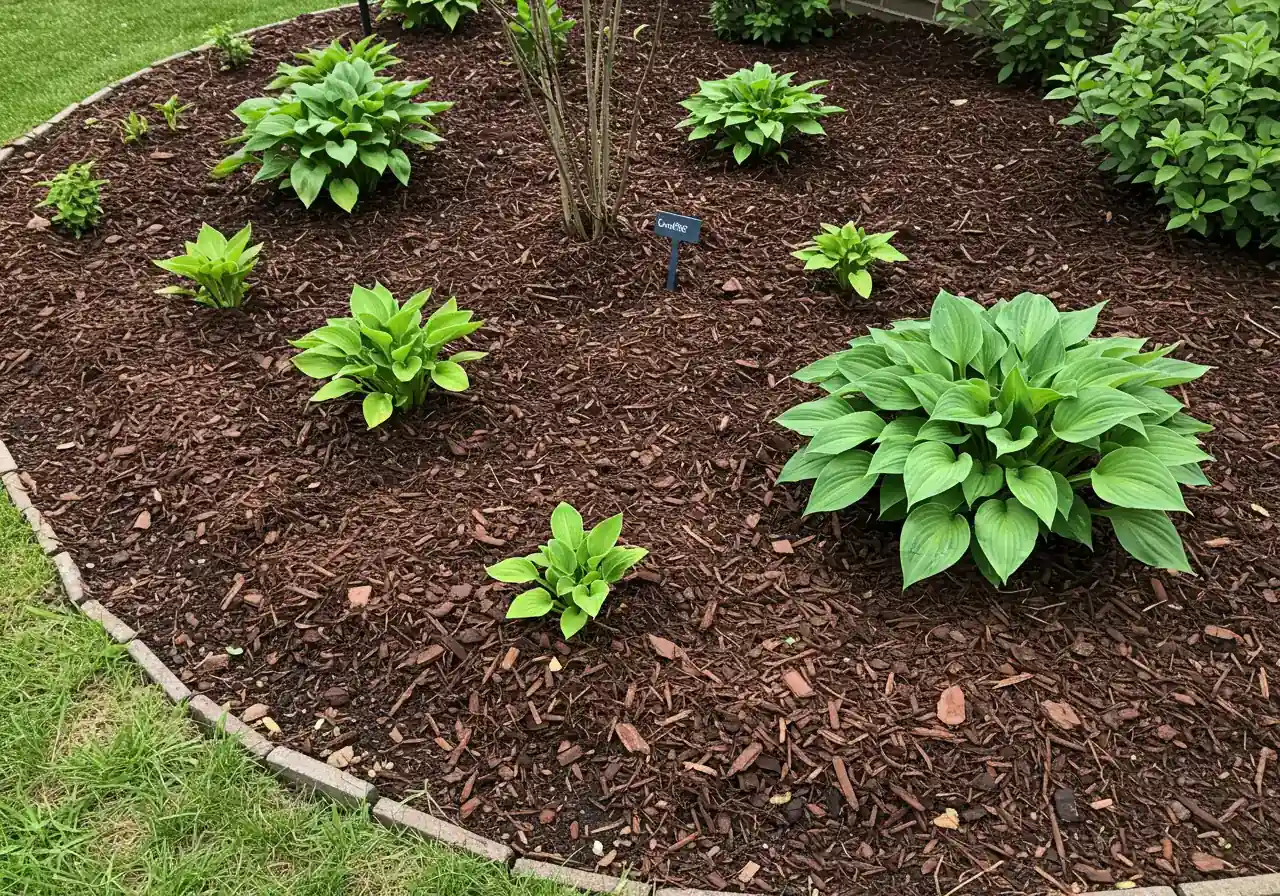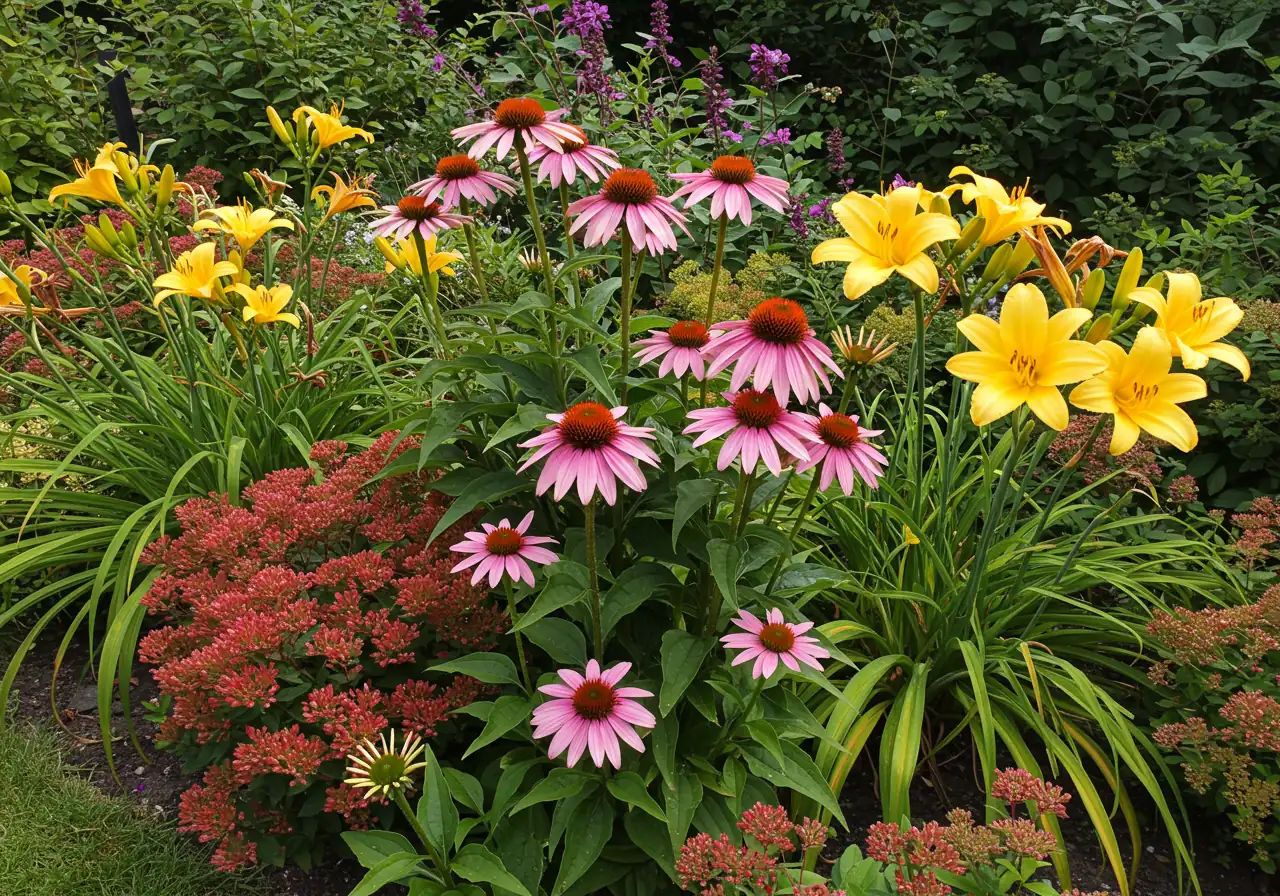Winchester Summer Plant Care Plan: Prevent Heat Stress
Quick Guide to Summer Plant Survival:
- Recognize signs of heat stress: wilting, scorched leaves, dropped flowers/fruit.
- Water deeply and early in the morning, targeting the root zone.
- Apply a 2-4 inch layer of organic mulch to conserve moisture and cool soil.
- Choose heat-tolerant plant varieties suited for Ottawa's climate.
- Provide temporary shade for vulnerable plants during intense heat.
Is your garden feeling the summer heat? Don't let the Winchester sun stress out your plants! Get expert help keeping your landscape healthy and vibrant all season long. Request a free quote today!
Introduction: Winchester's Summer Sizzle & Your Garden's Survival
Phew! Is it just me, or does Winchester sometimes feel like a giant outdoor sauna come July? Even our friends out in nearby Greely or Osgoode are likely feeling the sizzle. While we humans can grab an iced tea and find refuge near the air conditioning, our poor gardens and landscaping don't have it quite so easy. All that intense sunshine and those soaring temperatures can lead to something called plant heat stress. Think of it as your plant's way of saying, "I'm feeling totally overwhelmed and wilted by this heat!" – sound familiar after a long, hot day?
Don't worry, your beautiful flower beds, shrubs, and veggie patches don't have to throw in the trowel! This guide is your secret weapon against the summer swelter. We're here to provide a straightforward, preventive summer care plan. We'll share practical gardening tips focusing on smart watering techniques, essential soil care, and choosing heat-tolerant plants, all designed to help your garden not just survive, but thrive through the hottest days the Ottawa region throws our way. Let's keep those green spaces happy and healthy!
Decoding Distress Signals: Recognizing Plant Heat Stress in Your Ottawa Garden

Okay, let's talk plant communication! Unlike us humans who can grab a cool drink and complain loudly about the heat (and let's be honest, we do love a good grumble during a sticky Ottawa summer!), our garden plants have quieter ways of yelling, "Help! It's way too hot out here!" Learning to read these leafy distress signals is crucial for keeping your landscaping looking lush, whether you're in Barrhaven, Greely, or right here in Winchester.
So, what exactly is plant heat stress? Imagine trying to sip water through a tiny straw while running a marathon under the blazing July sun. That’s kind of what happens to your plants. When temperatures soar, plants lose water through their leaves (it’s called transpiration – fancy, right?) much faster than their roots can possibly absorb it from the soil. To survive, they might start to shut down vital processes, like growth or even photosynthesis, almost like they're closing up shop early to escape the heat. This internal struggle shows up in ways we can actually see.
Here are the main SOS signals your plants might be sending:
- The Big Wilt: This is usually the first and most obvious sign. Leaves look droopy, sad, and generally limp, like they’ve lost all their pep. You might notice this most during the hottest part of the afternoon, even if the soil still feels a little damp. Your beautiful hydrangeas or leafy veggie plants are often the first drama queens to wilt.
- Crispy Critters (Leaf Scorch): Keep an eye out for brown, dry, or "burnt" looking edges or patches appearing on the leaves. Sometimes, entire leaves might turn yellow or brown and feel brittle. This damage often appears first on the leaves getting the most direct, intense sunlight.
- Dropping Like It's Hot (Leaf, Flower, or Fruit Drop): When a plant gets really stressed, it starts conserving energy for survival. This might mean suddenly shedding perfectly healthy-looking leaves, buds, flowers, or even small, developing fruits. It's the plant's drastic way of reducing its workload.
- Hitting the Brakes (Stunted Growth): Is your usually vigorous tomato plant or favourite shrub suddenly not growing much? Extreme heat can significantly slow down or even stop new growth as the plant focuses all its energy on just staying alive.
Ottawa's summers, particularly those stretches of high heat and humidity, really push our gardens to their limits. That intense sun, often combined with periods of less rainfall, creates the perfect recipe for heat stress. Consistent observation is your best defence; regular Winchester summer garden health monitoring allows you to catch these signs early before serious damage occurs. Remember that building resilience starts before the heat hits; a solid Winchester garden health plan spring prep can give your plants a stronger start. Recognizing these symptoms means you can quickly implement helpful Winchester summer garden care tips to provide relief. And thinking long-term, choosing heat-tolerant species when designing your Winchester garden oasis can make summer gardening much less stressful. If keeping track of plant health feels like too much during a busy summer, know that reliable professional landscaping services are always an option to help keep your green space thriving.
Water Wisely: Quenching Thirst Without Drowning Your Plants

Alright, let's talk hydration! Giving your garden a drink seems simple enough, right? Turn on the hose, spray things down, done. But hold your horses (or garden gnomes)! Watering effectively, especially during Ottawa's summer sizzlers, is more art than just aiming and spraying. We want to quench our plants' thirst, not accidentally send them swimming with the fishes (metaphorically speaking, of course). Improper watering can waste water, encourage shallow roots, and even invite diseases. So, let's learn how to water like a pro!
First off, when you water is super important. Think early morning – like, before your first coffee, if you can manage! Watering early gives the water time to soak deep into the soil before the hot sun starts evaporating it away. It also allows the leaves to dry off during the day, which helps prevent fungal problems. Watering in the evening isn't terrible, but damp leaves overnight can be an open invitation for mildew and other unwanted guests. Watering midday? That's generally a no-no, as too much water is lost to evaporation before it even reaches the roots.
Next up: how deep? Forget those quick, shallow sprinkles. They might wet the surface, but they encourage roots to stay shallow, making plants more vulnerable to heat and drought. We want deep, infrequent watering. Think of it as giving your plants a long, satisfying gulp rather than tiny sips. This encourages roots to grow deeper into the soil where it stays cooler and moister, even when the surface is baking.
How to Achieve That Deep Drink:
- Check First: Stick your finger a couple of inches into the soil near your plants. Is it dry? Time to water! Still damp? Hold off. Overwatering can be just as harmful as underwatering.
- Go Slow and Low: Apply water slowly directly at the base of the plants (the root zone). Soaker hoses or drip irrigation systems are fantastic for this – they deliver water right where it's needed with minimal waste. Hand watering with a wand works too, just be patient! Sprinklers can be less efficient, losing a lot to evaporation and wind, and wetting foliage unnecessarily.
- Aim for Depth: Your goal is to moisten the soil down to about 6-8 inches for most garden plants, shrubs, and perennials. How long does this take? It depends on your soil! Sandy soil, like you might find in parts of Osgoode, drains quickly and needs water more often but perhaps for shorter durations each time. Heavier clay soil, sometimes found around Metcalfe, holds water longer, so you'll water less frequently but need to apply it slowly to avoid runoff. Getting the soil right often involves good preparation; a thorough spring clean-up can make a big difference - something our Metcalf Garden Clean Up Service team knows all about.
- Let it Soak: Water until the soil is thoroughly moist, but not waterlogged. You might need to water an area, let it soak in, and then water again.
- Mulch is Your Friend: A good layer of organic mulch (like shredded bark or compost) helps keep the soil cool and reduces evaporation significantly. It’s a key part of smart watering! If your beds are looking a bit bare, consider adding mulch after a good weeding session – it’s a common task included in our Winchester Garden Clean Up Service. See our mulching and edging service page for more details.
Special Cases:
- Container Plants: Pots and hanging baskets dry out much faster than garden beds, especially terracotta pots. Check them daily (sometimes twice daily in extreme heat) and water thoroughly until water drains from the bottom.
- Water Restrictions: Always be mindful of Ottawa's seasonal water restrictions! Watering wisely often means you use less water overall, helping you comply naturally. Using rain barrels to collect water is another great, eco-friendly strategy.
Mastering watering takes a little observation, but your plants will thank you with lush growth instead of sad wilting. It's a cornerstone of good landscaping maintenance. If setting up efficient watering systems or managing the overall health of your yard feels overwhelming, remember that professional help is available. Our team offers various landscaping and garden maintenance services across the region. From targeted clean-ups like our Metcalf yard cleanup service to comprehensive care, the goal of any good Ottawa Yard Cleanup Service is a healthy, thriving landscape. Curious about options for your space? We welcome you to check client feedback on our Google Business Profile or request an estimate and share your needs. Happy watering!
Mulch Ado About Summer: Your Garden's Protective Blanket

Okay, let's chat about mulch! It might seem like just a finishing touch, the decorative "jewelry" for your garden beds, but oh, it's so much more, especially during a hot Ottawa summer. Think of mulch as your garden's very own superhero cape, shielding it from the villainous heat and drought. It’s less about making a fuss and more about giving your plants a serious advantage when the sun beats down.
So, why is mulch such a big deal?
- Moisture Master: Mulch acts like a lid on your soil, significantly slowing down evaporation. This means the water you apply (remember our wise watering tips?) stays in the soil longer, keeping roots hydrated and happy. Less watering for you, more consistent moisture for your plants – win-win!
- Cool Operator: Bare soil heats up fast under the summer sun, stressing plant roots. A layer of mulch keeps the soil temperature more stable and cooler, creating a much friendlier environment for root growth. This is especially helpful in sun-baked areas, perhaps like some newer developments in Barrhaven or Nepean with less mature tree cover.
- Weed Warrior: A good mulch layer blocks sunlight from reaching weed seeds lurking in the soil, preventing many of them from sprouting. Fewer weeds mean less competition for water and nutrients for your beloved plants. Preparing the area is key; a thorough weeding, often part of a spring property clean up, sets the stage for effective mulching.
- Soil Improver (Organic Bonus!): Using organic mulches means that as they slowly break down, they add valuable organic matter to your soil, improving its structure and fertility over time. It’s an eco-friendly boost! Consider learning more about soil preparation for long-term garden health.
Choosing Your Mulch:
Organic mulches are fantastic for garden health. Here are a few popular choices suitable for our area:
- Shredded Bark (Pine, Cedar, Hemlock):
- Pros: Looks tidy, decomposes relatively slowly, stays put well, cedar can deter some insects.
- Cons: Can compact over time, may slightly acidify soil (usually not a major issue).
- Wood Chips:
- Pros: Often available locally (sometimes free from arborists!), good for pathways and larger areas, decomposes slowly.
- Cons: Can look less formal, may temporarily tie up nitrogen at the soil surface as it breaks down (add a little compost underneath if concerned).
- Compost:
- Pros: Excellent soil conditioner, adds nutrients directly, dark colour looks great.
- Cons: Decomposes faster so needs replenishing more often, may contain weed seeds if not fully composted.
- Straw:
- Pros: Great for vegetable gardens, lightweight, decomposes quickly adding organic matter.
- Cons: Can blow around easily, may contain weed/grain seeds, looks less formal.
How to Apply Mulch Like a Pro:
- Clean Up Crew: First, thoroughly weed the area. You don't want to mulch over existing weeds! This preparation is a standard part of many landscaping jobs, like those offered by an Ottawa Yard Cleanup Service. Even areas further out, like Marionville, benefit from this prep step often included in services like the Marionville property cleanup service.
- Spread Evenly: Apply a layer 2-4 inches deep over the soil surface. Too thin won't do the job, and too thick can suffocate the soil.
- Give 'Em Space: Crucially, pull the mulch back an inch or two from the base of plant stems and tree trunks. Piling mulch right against them traps moisture and invites rot and pests. Think donuts, not volcanoes!
- Finishing Touch: Smooth it out for a neat appearance. Mulch is often the final step after planting, complementing a fresh expert garden installation.
Applying mulch is a simple, effective way to support your garden through the summer heat. If you're hiring professionals for landscaping tasks, ensure you understand the scope of their mulching service; reviewing details upfront, much like understanding our service terms and conditions, ensures everyone is on the same page for a happy, healthy garden.
Deep Watering Essentials
Remember, early morning is best! Aim for 6-8 inches of soil moisture. Use soaker hoses or drip irrigation for efficiency. Check soil moisture before watering – don't drown your plants!
Why Mulch Matters
Mulch conserves soil moisture, suppresses weeds, regulates soil temperature, and (if organic) improves soil structure over time. Always leave space around plant stems.
Top Heat-Tolerant Picks
Consider Coneflower (Echinacea), Sedum 'Autumn Joy', Daylilies (Hemerocallis), Lantana (annual), and Yarrow (Achillea) for sunny, hot spots in your Winchester garden.
Plant Smarter, Not Harder: Choosing Heat-Tolerant Beauties for Winchester

Let's face it, nobody wants to spend their precious summer weekends coaxing sad, droopy plants back to life after every heatwave. Wouldn't it be nicer to relax and enjoy your garden, knowing it can handle the Winchester summer sizzle with a bit more grace? That’s where smart plant selection comes in! Choosing plants naturally suited to handle heat and potential dry spells is the secret weapon for a lower-stress, beautiful landscape.
Think of it like picking the right teammate for a summer sports league – you want someone who won’t wilt under pressure! Plants are the same. While Winchester and the greater Ottawa region are generally considered USDA Hardiness Zone 5a/5b (meaning plants need to survive our cold winters), summer toughness is a whole different ball game. Selecting heat-tolerant varieties means less frantic watering, fewer crispy leaves, and more consistent beauty right through August and September. See some inspiring garden transformations featuring hardy plants.
So, who are these garden superheroes? Here are some reliable performers that tend to shrug off the heat:
- Tough Perennials (Come back year after year):
- Coneflower (Echinacea): These daisy-like beauties come in stunning colours, love full sun, and are practically legendary for their heat and drought tolerance once established. Plus, pollinators adore them!
- Sedum 'Autumn Joy': A workhorse! Its fleshy leaves store water, helping it thrive in hot, dry spots. It offers interest from spring through fall, culminating in lovely pinkish-red flower heads.
- Daylilies (Hemerocallis): Available in a rainbow of colours, daylilies are famously easygoing. While some fancy hybrids might appreciate a bit more water, many common varieties handle heat beautifully.
- Yarrow (Achillea): With feathery foliage and flat-topped flower clusters, yarrow laughs at heat and poor soil. It's a fantastic, low-care option.
- Awesome Annuals (Season-long colour):
- Lantana: These bloom machines produce clusters of colourful flowers all summer long and absolutely thrive in heat and sun. Great in beds or containers.
- Vinca (Annual Catharanthus roseus): Glossy green leaves and cheerful, pinwheel-like flowers make Vinca a go-to for hot, sunny spots where other annuals might fail.
- Zinnias: Bright, bold, and easy to grow from seed, Zinnias love the sun and provide fantastic cut flowers. They just keep blooming through the heat.
- Portulaca (Moss Rose): This low-growing succulent thrives in the hottest, driest conditions – perfect for rock gardens or the edge of a blazing driveway.
- Sturdy Shrubs (The backbone of the garden):
- Potentilla: These dependable shrubs offer cheerful, button-like flowers (often yellow, white, or pink) throughout the summer and tolerate heat and dry spells once established.
- Spirea (some varieties): Look for varieties like 'Goldflame' or 'Magic Carpet'. Many spireas handle sun and heat well, offering colourful foliage and summer blooms.
- Ninebark (Physocarpus): Known for its interesting foliage colours (from burgundy to gold) and peeling bark, Ninebark is a tough native shrub that stands up well to various conditions, including heat.
Don't Forget Native Plants! Plants native to the Ottawa Valley region are naturally adapted to our climate extremes – including summer heat. Think about incorporating species like Wild Bergamot (Monarda fistulosa) or Black-Eyed Susans (Rudbeckia hirta). They often require less care and provide vital habitat for local wildlife. Check resources like the Ottawa chapter of Master Gardeners for local plant advice.
Microclimates Matter: Remember that even within your Winchester yard, or neighbouring areas like Kars, Vernon, or Kenmore, conditions can vary. A south-facing wall radiates heat, making that spot much hotter than a shadier corner. Plant your most heat-tolerant selections in these "hot spots." Good soil preparation is key everywhere; preparing your beds with a thorough property clean up can give new plants a great start. See how different plants fare in various local settings – you can even see examples of thriving gardens in our gallery.
Tips for Success:
- Read plant tags carefully, looking for terms like "full sun," "heat tolerant," or "drought tolerant."
- Observe what thrives in your neighbours' yards – local proof is powerful!
- Improve your soil with compost before planting. This helps retain moisture. Consider this as part of a regular Ottawa garden clean up service or a specific spring prep task.
- Even heat-tolerant plants need consistent watering to get their roots established in the first season. After that, they become much more self-sufficient. Starting with a clean slate helps too, similar to the prep work done by our Marionville yard cleanup service team. And if keeping things tidy feels overwhelming, professional help is available, like our dedicated Marionville garden clean up service focusing purely on garden beds.
By choosing plants that work with our summer conditions instead of fighting against them, you can create a stunning, resilient garden that brings joy, not stress. Happy planting!
Estimated Water Savings with Mulch (Summer Months)
Throwing Shade: Smart Strategies to Cool Your Garden Canopy
Okay, let's be real, even the most sun-loving plants can use a little break from the intense Ottawa summer sun sometimes. Just like we reach for a hat or sunglasses, our garden canopy occasionally needs some relief. Providing shade isn't about turning your yard into a cave; it's about strategically reducing that harsh afternoon glare, especially for more delicate plants or veggies prone to wilting or sun scald. Think of it as giving your plants a cool drink and a spot under the umbrella!
So, how do we throw shade (the good kind!) in the garden?
- Built-In Relief (Physical Structures): For consistent shade in specific areas, consider structures.
- Shade Cloth: You can buy fabric designed to block a certain percentage of sunlight. Drape it over hoops or attach it to stakes above sensitive plants like lettuce or newly planted seedlings. It’s a flexible and effective option.
- Lattice Screens or Fences: Strategically placed screens can block the harshest afternoon sun while still allowing air circulation. They can also add a lovely design element!
- Pergolas and Arbors: These larger structures can provide dappled shade, perfect for patios or sitting areas, and climbing plants love them. Just ensure you're considering durable material selection for longevity against our Canadian weather.
- Let Nature Help (Plant Power): Use plants to shade other plants! This is a classic technique you often see in established landscapes in communities like Russell or Embrun.
- Companion Planting: Plant taller, sun-loving plants (like sunflowers or corn) to the south or west side of shorter, more vulnerable ones (like bush beans or spinach). The big guys take the heat, giving the little guys a break.
- Leverage Existing Features: Use the shade cast by existing trees, shrubs, or even your house. Plant shade-tolerant species like hostas or ferns on the north or east side where they get morning sun but afternoon protection. Remember, areas shaded by trees might impact nearby lawn care too, often requiring different grass seed mixes or watering schedules. Good sod installation practices consider shade levels.
- Quick Fixes (Temporary Solutions): Sometimes you just need shade now.
- Patio Umbrellas: Repositionable umbrellas can be surprisingly effective for shading smaller garden beds or containers during peak heat.
- Row Covers: Lightweight fabric row covers can offer temporary shade, especially for rows of vegetables.
- Moveable Containers: One benefit of container gardening! Simply move pots to a shadier spot during intense heat waves.
Implementing shade strategies is a key part of proactive summer garden maintenance. Sometimes setting up these solutions requires a bit of ground prep, like clearing space similar to work done by a property cleanup service before installing posts for shade cloth. Finding the right shade solution brings welcome relief, and both you and your plants will feel a sense of gratitude and thanks for the cooler, less stressful conditions. A little shade can make a big difference in keeping your garden happy and productive through the hottest days!
Quick Summer Survival Tips
Feeling the heat? Don't let your garden wilt! We get it – Ottawa summers can be tough on plants (and people!). Here at Clean Yards, keeping green spaces thriving is kind of our thing (you can learn more about our approach and team), so here are our top quick tips to help your garden beat the heat:
- Water Wisely: Ditch the quick evening sprinkle! Water deeply in the early morning right at the roots. This encourages strong roots and less wasted water, especially crucial during Ottawa's dry spells.
- Mulch is Magic: Apply a 2-4 inch layer of organic mulch (wood chips, bark, compost) around your plants – but not touching the stems! It keeps soil cool, holds moisture, and smothers weeds. Like a cozy blanket, but for summer.
- Read the Leaves: Learn your plant's SOS signals! Watch for wilting, brown leaf edges (scorch), or dropped flowers. Catching heat stress early makes a huge difference.
- Pick Tough Cookies: Choose heat-tolerant plants like Coneflowers, Sedum, or Lantana for sunny spots. They're naturally better equipped to handle the sizzle, leading to less worry for you.
- Strategic Shade: Use shade cloth, taller companion plants, or even a patio umbrella to shield vulnerable plants from the intense afternoon sun, particularly in exposed areas like some Manotick gardens might have.
- Give Soil Some Love: Healthy plants start with healthy soil! Good structure helps retain moisture, making plants more resilient. Investing time in proper soil preparation pays off all summer long.
- Holistic Yard Health: A tidy garden is often a healthier garden. Removing debris and keeping things neat reduces plant stress. If things get overwhelming, a professional Ottawa property cleanup service can reset the stage. Remember, a healthy lawn complements your beds, so keep up with appropriate summer lawn care practices too!
Simple Summer Care Timeline
Early Summer (June)
Apply mulch after spring cleanup. Ensure deep watering for establishing plants. Monitor for early pest signs.
Mid-Summer (July-August)
Peak heat! Monitor watering needs closely, especially during dry spells. Watch for heat stress signs. Deadhead spent flowers.
Late Summer (Late Aug-Sept)
Assess plant health after heat stress. Plan fall planting or cleanup. Adjust watering as temps cool slightly. Continue weeding.
FAQs: Your Winchester & Ottawa Summer Plant Care Questions Answered
Help! Ottawa often has summer water restrictions. How can I keep my garden alive without getting in trouble?
Great question! Watering wisely is key during restrictions. Always water early in the morning (like, really early!) to minimize evaporation. Focus on deep, less frequent watering right at the base of your plants using a soaker hose or watering wand – this gets water to the roots where it's needed most. Applying a good layer of mulch is your secret weapon; it keeps the soil cooler and holds onto moisture longer. Also, consider collecting rainwater in barrels for your thirsty plants. Following these tips usually aligns well with restriction guidelines, keeping both your garden and the city happy! Check the City of Ottawa website for current rules.
My soil around Metcalfe/Osgoode is heavy clay. It's either rock hard or a swamp! How do I water effectively in summer?
Ah, classic Ottawa region clay soil – we know it well! The trick is slow and steady. Clay holds water well but absorbs it slowly. Avoid blasting it with water, which causes runoff. Instead, apply water slowly over a longer period. Let it soak in, then maybe water again a bit later. Adding organic matter like compost is crucial. It improves drainage and water retention, making the soil less prone to cracking when dry or turning into goo when wet. Improving soil structure is often part of preparing beds, like the work included in a thorough Metcalf Garden Clean Up Service. It takes time, but amending clay soil makes summer watering much easier.
What are these tiny bugs munching on my plants? Summer pests are driving me nuts!
Ugh, pesky summer critters! Aphids, spider mites, and Japanese beetles are common culprits in our area. Early detection is key! Regularly check the undersides of leaves. For aphids and mites, a strong spray of water can knock them off, or use insecticidal soap (follow directions carefully!). Japanese beetles are often best dealt with by hand-picking them into soapy water in the morning when they're sluggish. Avoid broad-spectrum pesticides that harm beneficial insects. Healthy, well-watered plants are less susceptible to pests. For identification help, consult resources from the Ontario Ministry of Agriculture, Food and Rural Affairs (OMAFRA). If you're overwhelmed by an infestation and need advice or help, you can always book an estimate with us to discuss potential solutions.
Should I be fertilizing my plants during the really hot weather?
Generally, it's best to ease up on heavy fertilizing during peak summer heat. When plants are stressed by high temperatures, pushing them to produce lots of new growth with fertilizer can actually add more stress. Focus on consistent watering and maintaining soil health with compost or mulch. If you do fertilize, use a balanced, slow-release type or a diluted liquid feed, and apply it during cooler periods, never when plants are wilted or the soil is bone dry. Let your plants focus their energy on surviving the heat first!
My container plants seem to dry out instantly in the summer sun! How can I keep them happy?
Container plants are definitely needier in summer! They have less soil volume and heat up faster. Check them daily, sometimes even twice on scorching days, by sticking your finger an inch deep. Water thoroughly until water drains from the bottom holes. Larger pots dry out slower than small ones. Consider grouping pots together to create a more humid microclimate. Applying a thin layer of mulch on top of the soil helps too. For managing your garden care schedule, including reminders for thirsty containers, existing clients find our customer portal quite handy.
I'm planting a new bed in Greely next spring. What are some super tough, heat-tolerant plants you recommend for sunny spots?
Excellent idea to plan ahead for heat tolerance! For sunny spots in areas like Greely, you can't go wrong with perennials like Coneflowers (Echinacea), Sedum 'Autumn Joy', Daylilies, or Yarrow. They handle heat and potential dry spells like champs once established. For annual colour, Lantana, annual Vinca, and Zinnias thrive in full sun and keep blooming through the heat. Remember native plants too – Black-Eyed Susans (Rudbeckia) are cheerful and tough. Choosing wisely means less summer stress for you and your garden! When you book services or request information, please know your personal details are handled carefully, as outlined in our Privacy Policy.
Conclusion: Keep Your Cool & Your Garden Gorgeous This Summer
Phew! We've navigated the summer garden gauntlet together. Remember, beating the heat in Winchester, Manotick, or anywhere across the Ottawa region doesn't require horticultural wizardry – just a little know-how. By learning to spot those leafy SOS signals (hello, wilting!), watering deeply and smartly in the early morning, embracing the protective power of mulch, choosing plants that actually like the sun, and maybe throwing a little strategic shade, you're well on your way. A stunning summer garden isn't just a dream, even when the temperatures soar!
Keeping your landscaping looking lush takes effort, and sometimes summer life gets busy. If you'd rather spend your weekends enjoying the weather than battling weeds or worrying about watering, we can help. Clean Yards offers expert garden maintenance services designed to keep your plants thriving all season long. Feeling overwhelmed or just need a hand getting started? Need a complete yard cleanup in Marionville or surrounding areas? **Reach out to us today for a free estimate** and let's chat about how to make your garden the envy of the neighborhood, minus the heat stress! You can easily contact us through our website. Here's to a cool, vibrant, and gorgeous garden this summer!

